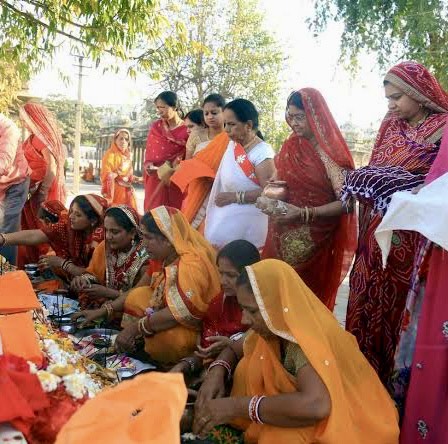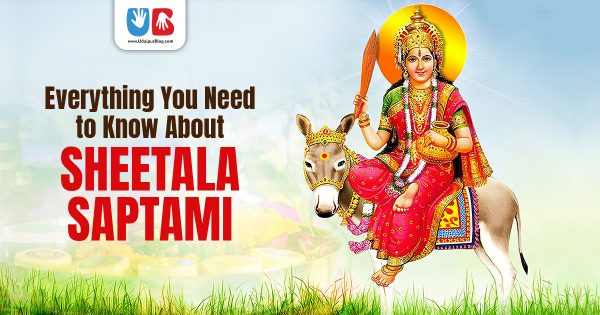Sheetala Saptami is one of the most well-known Hindu festivals. Hindus observe Sheetala Saptami on (saptami) the seventh day of the month of Chaitra during Krishna Paksha which occurs seven days after Holi. This day is celebrated in honour of Goddess Shakti’s feminine power and incarnation, Goddess Sheetala who is believed to be the goddess of smallpox and other infectious diseases. People offer prayers and seek her blessings to avoid contracting diseases like chicken pox and smallpox to safeguard themselves and their families. Different cultures commemorate Sheetala Saptami (also known as Sheetala Satam in some regions and cultures) or Sheetala Ashtami (also known as Basoda in some regions and cultures), depending on whether it occurs seven days after Holi (Saptami) or eight days after Holi (Ashtami). We majorly celebrate Sheetala Saptami in Udaipur.

Significance and History of Sheetala Saptami:
Maa Sheetala, according to myth, is a manifestation of Goddess Parvati, who appeared during the Gods’ sacramental fire rite (Havan). One of the Goddess’s four hands is said to carry a dustpan, and the other is said to hold a broom, some dawning neem leaves, and a water pitcher. She travels in a mule. Although the first two depict cleanliness, the pitcher stresses the importance of clean water for all life on Earth, and neem is known for its therapeutic benefits. During the Havan, a bead of Lord Shiva’s sweat fell to the ground, and a demon known as Jwarasura (literally: Fever-demon) rose from the soil. Jwarasura is revered as the fever-deity who harmed humanity by dispersing illnesses throughout the globe. To beseech the Goddess to protect our families and ourselves from heat-related illnesses, we perform the Sheetala Saptami puja. It is widely believed that Goddess Sheetala aids in the prevention of infectious illnesses like measles, chickenpox, and smallpox.

Rituals of Sheetala Saptami:
– Devotees worship Sheetala Mata on this particular day and give prayers to her.
– Before the sun rises, people get up early and take a cold bath.
– After that, they go to the shrine of Goddess Sheetla to perform various rituals and puja and offer prayers to the deity in order to lead a happy, healthy, and peaceful life.
– The day of Sheetala Saptami is a day when devotees abstain from cooking and only consume food that has already been made the day before. On this specific day, eating hot, freshly baked food is strictly forbidden.
What Is Sheetala Saptami’s Importance?
Sheetala Saptami is an important festival in Hinduism, and holds great significance for devotees. Here are some of the reasons why this festival is considered important:
1. Worship of Goddess Sheetala: The Skanda Purana gives a detailed explanation of the significance of the Sheetala Saptami. According to the texts and Hindu mythology, Goddess Sheetala is an incarnation of Maa Parvati and Goddess Durga. The goddess Sheetala stands for nature’s ability to restore. The deity is worshipped and prayed to for protection against diseases like chicken pox and smallpox by devotees and their offspring on this auspicious day. Sheetala, when used literally, refers to cold or coolness.
2. Purification of the body and surroundings: The event also stresses the value of hygiene and cleanliness. To get rid of any bad karma and stop the spread of illness, people clean their homes and surroundings.
3. Observance of fast: Many devotees observe a fast on Sheetala Saptami to show their devotion and seek the blessings of the goddess. The fast is believed to cleanse the body and purify the mind.
4. Rituals and traditions: The “Kiriya” ritual and the offering of seven different kinds of grains and vegetables to the goddess are two rituals and customs connected to the celebration. These customs are thought to bring prosperity and shield people from illnesses.
5. Social significance: Sheetala Saptami is also an occasion for people to come together and celebrate as a community. People can show their gratitude for their blessings and deepen their bonds with friends and family during the festival.
6. Offering to Brahmins: In some regions, devotees offer food and donations to Brahmins as a part of the Sheetala Saptami celebrations.
A day of no cooking

The devotees refrain from eating any recently cooked food or hot or warm food throughout the day and don’t ignite any stoves in the kitchen.
According to the shastras (ancient principles), simple, non-spicy, cold food stored securely from the day before is advised to be consumed on this day as a digestive system relaxant. chilly is Sheetal. The Sheetala Mata vrat includes “sheetal” (cold, calming) food to soothe the stomach and provide it with simple-to-digest food.
A day before the celebration, people cooks oliya which is considered to be the most important food item and is also offered to goddess sheetala while performing the puja.
Due to the fact that Sheetala Saptami falls at the start of summer, which in many ways signifies the beginning of summer season and the change from spring to summer in a country like India, foods that are high in heat and seasonings only exacerbate bodily conditions and make digestion more challenging. People concur that basic food can be eaten for at least one day as a result and they usually eat food items like oliya, aaloo ki sabzi, panchkuta (ker sangari), puri, bhindi, and amchur.
Sheetala Saptami significance still remains strong today, as people have noticed that the belief also stays true to science.


